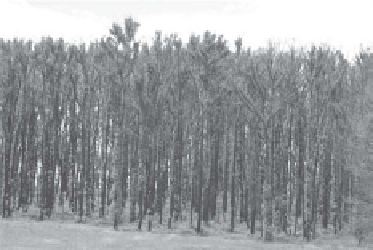Agriculture Reference
In-Depth Information
(a)
(b)
(c)
(d)
Fig. 3.3
Epicormic sprouting in (a) Mediterranean Basin oak
(Quercus suber)
, characteristic of
most arborescent oaks, (b) California chaparral conifer,
Pseudotsuga macrocarpa
,an
uncommon trait in gymnosperms, (c)
Eucalyptus
from Australia, and (d) a forest of epicormically
resprouting
Eucalyptus
from Victoria, Australia, illustrating stand level recovery 11 months after
a high-intensity fire in February 2009. (Photos by Felipe Catry, a, and Jon Keeley, b-d.)
Oechel
1994
). Climate plays a role since intense droughts induce vegetation die-
back, thus increasing dead fuels, as well as reducing live fuel moisture, both of
which will increase fire intensity and reduce resprouting. Shorter fire intervals, and
fires at certain seasons, potentially deplete carbohydrate reserves and this is tied to
reduced resprouting (Rundel
et al.
1987
; Haidinger & Keeley
1993
; Canadell &
Lo´ pez-Soria
1998
; Cruz
et al.
2003a
), although dependence on stored




